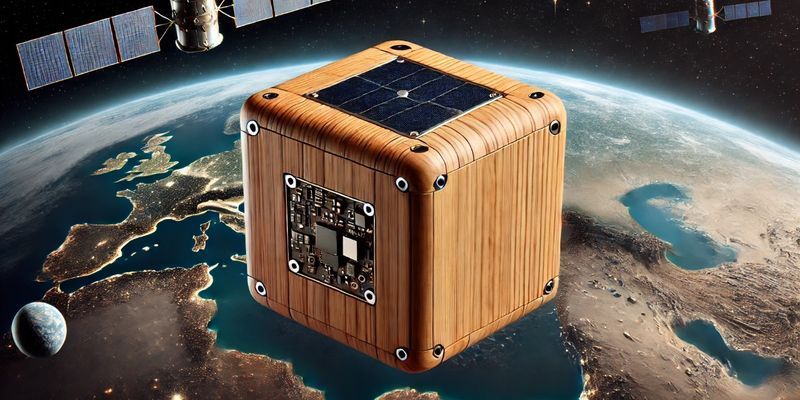In a groundbreaking leap for sustainable space exploration, Japan has launched the world’s first wooden satellite, aptly named LignoSat. This innovative endeavor, a collaboration between Kyoto University and Sumitomo Forestry, aims to assess the viability of timber as a material for space applications, potentially revolutionizing satellite construction and addressing the growing concern of space debris.
The Genesis of LignoSat

The concept of a wooden satellite emerged from the need to find eco-friendly alternatives to traditional satellite materials. Conventional satellites, primarily constructed from metals like aluminum, pose environmental challenges upon re-entry, releasing harmful particles that can affect the ozone layer and contribute to space debris. In contrast, wood offers a biodegradable solution, burning completely during re-entry without leaving harmful residues.
After extensive research, magnolia wood was selected for LignoSat due to its high workability, dimensional stability, and overall strength. This choice was reinforced by successful tests conducted aboard the International Space Station (ISS) in 2022, where magnolia wood samples demonstrated resilience against the harsh conditions of space, including extreme temperature fluctuations and exposure to cosmic rays.
Launch and Mission Objectives

On November 5, 2024, LignoSat was launched aboard a SpaceX Falcon 9 rocket, marking a historic moment in space technology. The satellite, measuring 10 centimeters on each side and weighing approximately 1 kilogram, was deployed into orbit from the Japanese experimental module Kibo on the ISS.
Over the next six months, LignoSat will orbit Earth, collecting data to evaluate the durability of wood in space. Instruments onboard will monitor the wood’s resistance to temperature variations, radiation, and other environmental factors. This data is crucial for determining the feasibility of using wood in future space structures, such as satellites and potentially even habitats on the Moon or Mars.
Environmental Implications
The use of wood in satellite construction presents significant environmental benefits. Traditional metal satellites, upon re-entry, can produce aluminum oxide particles, which are known to deplete the ozone layer and contribute to atmospheric pollution. In contrast, wooden satellites like LignoSat are expected to burn up entirely, leaving minimal environmental impact.
Moreover, wood’s natural properties allow for better permeability to radio waves, potentially enhancing communication capabilities. This characteristic could lead to more efficient designs for future satellites, reducing the need for external antennas and minimizing the risk of components detaching and becoming space debris.
While the wooden satellite presents a promising step towards sustainability in space, there’s an inherent paradox in the pursuit. On the one hand, wood offers clear environmental benefits—biodegradability, minimal impact upon re-entry, and the potential to reduce space debris. However, if this technology proves successful, it could inadvertently introduce the space industry to the complex issue of deforestation.
As demand for wooden satellites increases, so too might the need for specific types of wood that can endure the harsh conditions of space. If large-scale production follows, this could strain forestry resources, potentially encouraging deforestation to meet industry demand. This outcome would directly conflict with the goal of sustainability, raising questions about whether the net environmental impact would truly be positive. Magnolia trees, for instance, are already facing conservation concerns in some regions, and their use in space applications could accelerate depletion if not managed responsibly.
Moreover, the potential expansion of a “space forestry” industry—one that cultivates and harvests wood specifically for satellites and other space-related structures—poses ethical and environmental questions. Forestry management for such specific demands would need careful regulation to prevent unsustainable harvesting practices and ensure reforestation efforts match or exceed timber consumption rates. Without these controls, the environmental cost could overshadow the intended eco-friendly advantages of wooden satellites.
Future Prospects
The success of LignoSat could pave the way for broader applications of wood in space technology. Researchers envision the construction of wooden structures in space, leveraging wood’s sustainability and structural benefits. For instance, Sumitomo Forestry has plans to build the world’s tallest wooden skyscraper in Tokyo by 2041, demonstrating the versatility and potential of wood in modern construction.
In the context of space exploration, wooden habitats could offer sustainable living solutions on extraterrestrial bodies. Wood’s insulating properties and ease of assembly make it a promising candidate for building habitats on the Moon or Mars, providing protection against harsh environmental conditions while minimizing the ecological footprint.
While LignoSat represents a fascinating experiment in material innovation, it also reminds us of the delicate balance between technological progress and environmental stewardship. As we look toward the future of space tech, responsible resource management must remain a central priority to ensure that sustainability efforts here on Earth aren’t undermined by our ambitions beyond it.










